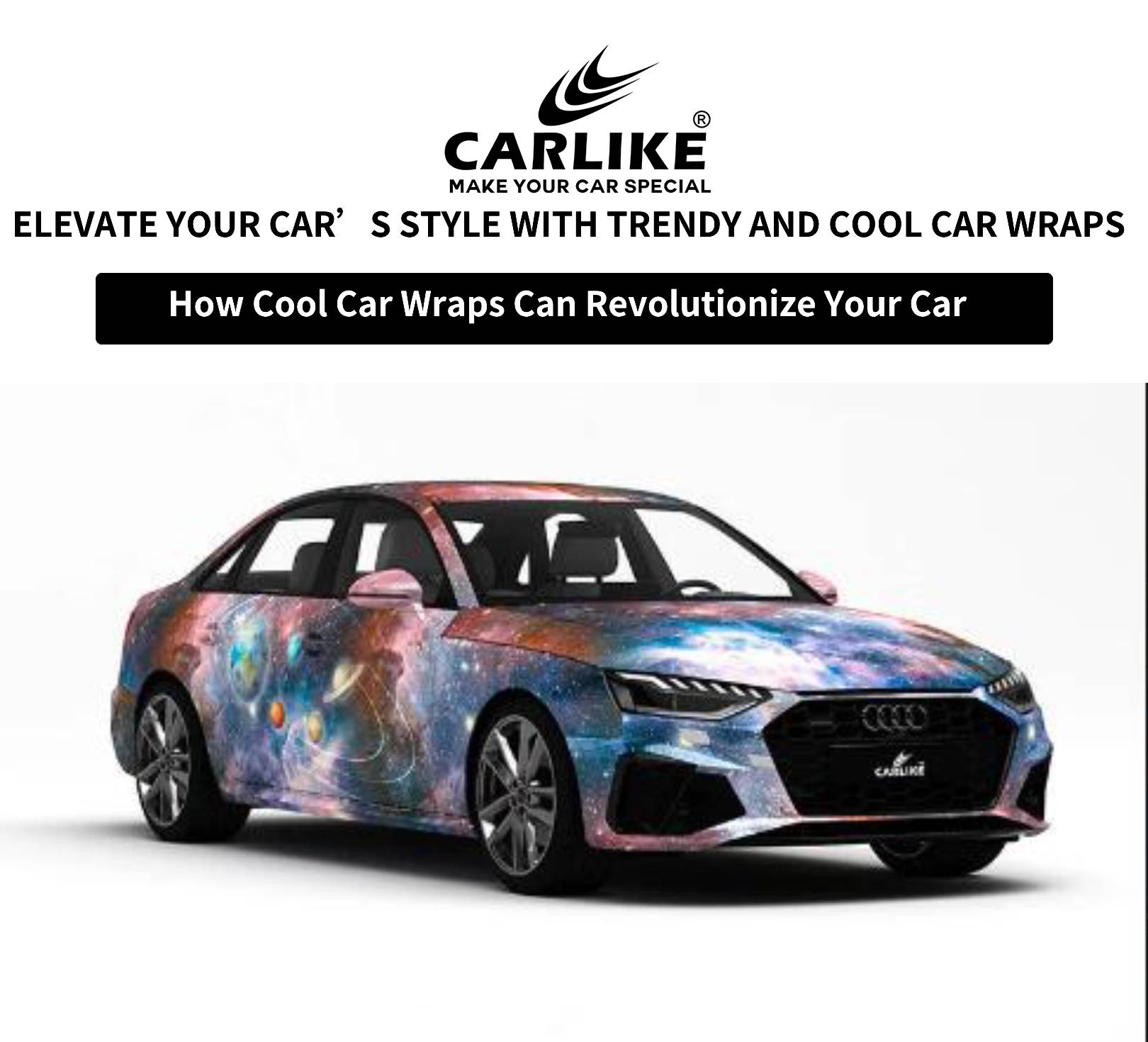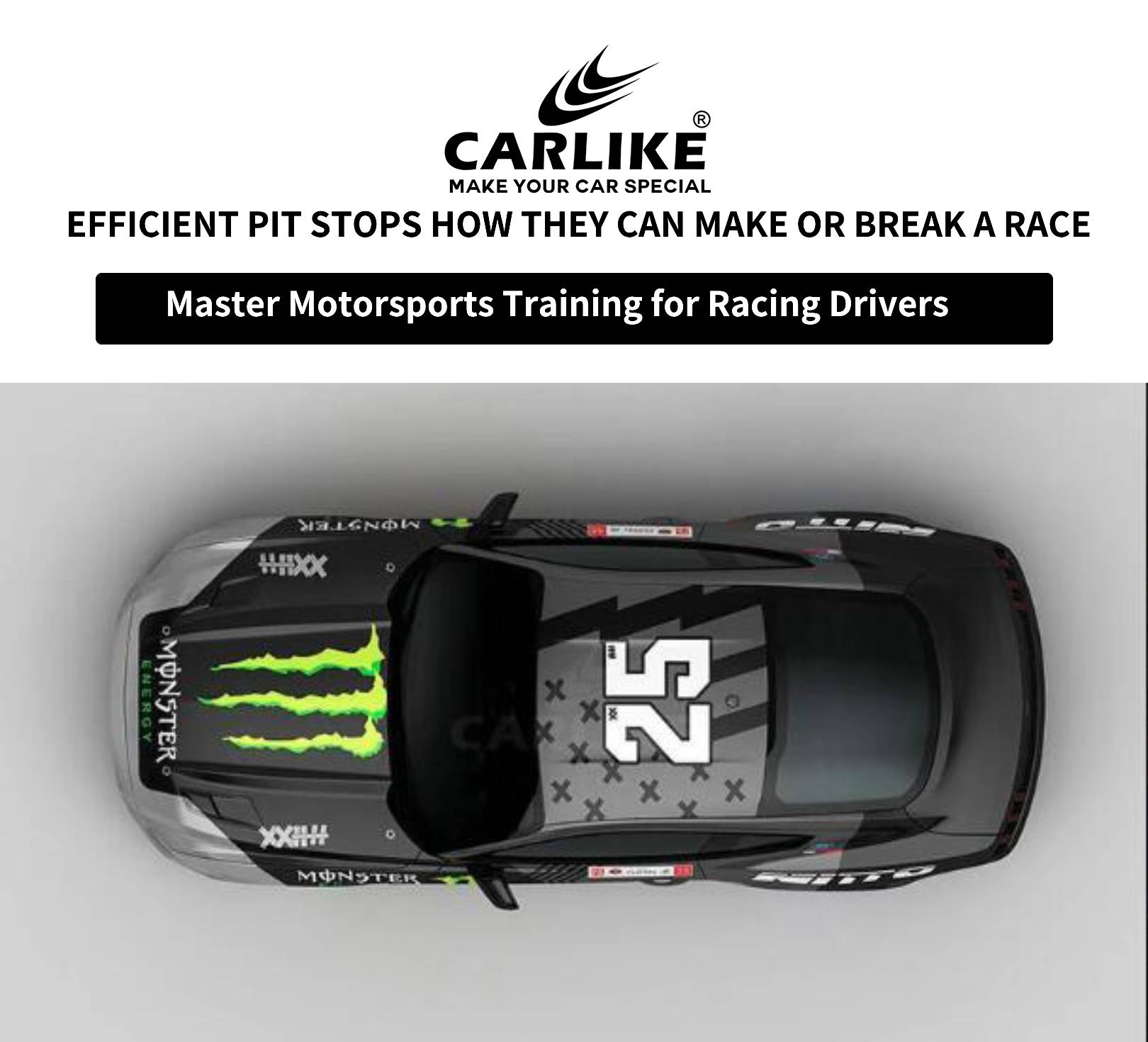CARLIKE-Make Your Car Special.

Customize your own car
Premium+ colored printed customized graphics car wraps
Epson high-precision printing
Customized by car model
Multiple colors with gloss or matte surface
what car wraps are and how they work?
Car wraps are a popular method of changing the appearance of a vehicle without altering its original paint job permanently. Essentially, a car wrap is a large vinyl graphic or decal that adheres to the surface of a vehicle. It can completely cover the vehicle or be applied to specific sections, such as the hood, roof, or doors.
how car wraps work
- 1. Design and Printing: The process begins with designing the wrap digitally. This design is then printed onto large vinyl sheets using specialized printers that can handle the size and detail required for wrapping vehicles.
- 2. Preparation: Before applying the vinyl wrap, the vehicle's surface is cleaned thoroughly to remove any dirt, wax, or other contaminants that could affect adhesion.
- 3. Application: The vinyl wrap is carefully applied to the vehicle by skilled installers. They use heat guns and squeegees to smooth out the vinyl, ensuring it adheres properly to the contours and curves of the vehicle.
- 4. Trimming and Finishing: Once applied, excess vinyl is trimmed away from edges and areas where the wrap ends. Installers pay close attention to details like door handles, mirrors, and other features to ensure a seamless appearance.
- 5. Curing: After application, the vinyl needs time to cure properly. This allows the adhesive to bond fully with the vehicle's surface, ensuring durability and longevity.
Car wraps offer several advantages, including protecting the original paint from minor scratches and UV damage, providing a customizable look, and enabling easy removal without damaging the paint underneath. They are popular among businesses for advertising purposes and among individuals looking to personalize their vehicles.
Why Choose Car Wraps?
Advantages over traditional paint
comparing car wraps to traditional car painting, several factors come into play, including cost, time, and flexibility.
cost
Car Wraps : Typically, a full car wrap can cost anywhere from $2,500 to $5,000, depending on the quality of the vinyl, the complexity of the design, and the size of the vehicle. Partial wraps are less expensive and can be a cost-effective way to change the look of a vehicle.
Traditional Car Painting : A high-quality paint job can range from $3,000 to $10,000, depending on the type of paint, the complexity of the job, and the amount of prep work required. Basic paint jobs might be cheaper but usually don’t offer the same level of finish and durability.
Time
Car Wraps : The application process for car wraps is relatively quick, often taking between 1 to 3 days. This includes the time needed for design, preparation, application, and curing.
Traditional Car Painting : Painting a car is more time-consuming, typically taking from a few days to a couple of weeks. This includes the time for surface preparation, multiple layers of paint application, drying times between coats, and the final clear coat application and curing.
Flexibility
Car Wraps : Vinyl wraps offer greater flexibility in terms of design and customization. They can incorporate complex graphics, patterns, and even textures (such as matte, gloss, or carbon fiber finishes) that would be difficult or very expensive to achieve with paint.
Traditional Car Painting : While high-quality custom paint jobs can achieve excellent results, they are less flexible in terms of easily changing designs or incorporating intricate patterns. Custom paint jobs can be very expensive and time-consuming to alter.
CARLIKE-Make Your Car Special.
How to Choose the Perfect Car Wrap
When choosing the perfect car wrap, several considerations come into play, including the car model, personal style, and intended use. Here’s a detailed discussion on these factors and tips on selecting colors and designs that complement the car’s shape and style:
Considerations
Car Model
- Shape and Lines : The shape, lines, and curves of your car can influence how well certain designs and colors work. For example, bold graphics might look great on a sports car with sleek lines but may not suit a more conservative sedan.
- Size : The size of the car affects the wrap's coverage and cost. Larger vehicles require more material, which can impact the overall price.
- Make and Model : Specific car models have unique features and contours that can affect the wrap's installation. High-end luxury cars might require more precise and professional application to ensure the wrap complements their premium look.
Personal Style
- Color Preferences : Choose colors that reflect your personal taste. Whether you prefer bright, bold colors or subtle, muted tones, the wrap should align with your personality.
- Design Preferences : Consider whether you like minimalist designs, complex graphics, or themed wraps. Your personal style should guide the choice of patterns and textures.
Intended Use
- Commercial Use : If the car wrap is for advertising, it should include branding elements such as logos, contact information, and eye-catching graphics that align with your business identity.
- Personal Use : For personal vehicles, the focus can be on aesthetics and individual expression. Think about how the wrap will be perceived by others and how it will reflect your lifestyle.
- Resale Value : If you plan to sell the vehicle in the future, consider choosing a wrap that is easy to remove and won’t affect the resale value. Neutral and popular colors might be preferable.
Tips on Selecting Colors and Designs
-
Complementing the Vechile's Shape and Style
- Flow with Lines : Choose designs that flow with the natural lines and contours of the vehicle. This ensures the wrap enhances the car's design rather than clashing with it.
- Accentuate Features : Use color contrasts and patterns to highlight features like the hood, roof, or side panels. For example, a racing stripe can add a sporty look to certain models.
-
Color Selection
- Consider the Original Paint : If parts of the original paint will remain exposed, ensure the wrap colors complement the existing paint.
- Use Color Theory : Apply basic color theory to select hues that work well together. Complementary colors (opposites on the color wheel) can create striking contrasts, while analogous colors (next to each other on the color wheel) offer harmonious blends.
- Matte vs. Gloss : Decide between matte, gloss, satin, or textured finishes. Matte wraps can give a sophisticated look, while gloss wraps can enhance the vehicle's shine and vibrancy.
-
Design Choices
- Keep it Simple : For a classic and timeless look, simpler designs often work best. Complex graphics can be overwhelming and may not age well.
- Bold Statements : If you want to make a bold statement, go for vibrant colors and unique patterns. However, ensure they are professionally designed to avoid looking too busy or uncoordinated.
- Reflect Personal Interests : Custom wraps can incorporate elements that reflect personal interests, such as hobbies or favorite themes, to make the vehicle truly unique.
-
Quality of Material
- Invest in Quality : Higher-quality vinyl wraps are more durable, easier to apply, and offer better finishes. They also last longer and can withstand environmental factors better.
- Professional Installation : Ensure the wrap is installed by professionals to avoid issues like bubbling, peeling, and poor alignment. Skilled installers can also provide valuable advice on design choices.









